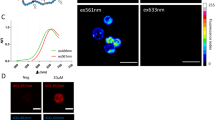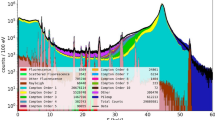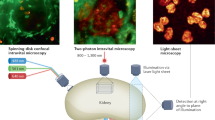Abstract
Immunological reactions have a key role in health and disease and are complex events characterized by coordinated cell trafficking to specific locations throughout the body. Clarification of these cell-trafficking events is crucial for improving our understanding of how immune reactions are initiated, controlled and recalled. As we discuss here, an emerging modality for revealing cell trafficking is bioluminescence imaging, which harnesses the light-emitting properties of enzymes such as luciferase for quantification of cells and uses low-light imaging systems. This strategy could be useful for the study of a wide range of biological processes, such as the pathophysiology of graft-versus-host and graft-versus-leukaemia reactions.
This is a preview of subscription content, access via your institution
Access options
Subscribe to this journal
Receive 12 print issues and online access
$209.00 per year
only $17.42 per issue
Buy this article
- Purchase on Springer Link
- Instant access to full article PDF
Prices may be subject to local taxes which are calculated during checkout




Similar content being viewed by others
References
Negrin, R. S. & Blume, K. in Williams Hematology 7th edn Ch. 22 (eds Lichtman, M. A. et al.) 209–247 (McGraw-Hill Professional, 2005).
Ferrara, J. L. & Deeg, H. J. Graft-versus-host disease. N. Engl. J. Med. 324, 667–674 (1991).
Kaitin, K. I. Graft-versus-host disease. N. Engl. J. Med. 325, 357–358 (1991).
Sykes, M. & Nikolic, B. Treatment of severe autoimmune disease by stem-cell transplantation. Nature 435, 620–627 (2005).
Thomas, E. D., Storb, R. & Clift, R. A. Bone-marrow transplantation. N. Engl. J. Med. 292, 832–843 (1975).
Thomas, E. D., Storb, R. & Clift, R. A. Bone-marrow transplantation. N. Engl. J. Med. 292, 895–902 (1975).
Storb, R. et al. Stable mixed hematopoietic chimerism in dogs given donor antigen, CTLA4Ig, and 100 cGy total body irradiation before and pharmacologic immunosuppression after marrow transplant. Blood 94, 2523–2529 (1999).
McSweeney, P. A. et al. Hematopoietic cell transplantation in older patients with hematologic malignancies: replacing high-dose cytotoxic therapy with graft-versus-tumor effects. Blood 97, 3390–3400 (2001).
Lowsky, R. et al. Protective conditioning for acute graft-versus-host disease. N. Engl. J. Med. 353, 1321–1331 (2005).
Wu, Y. L. et al. In situ labeling of immune cells with iron oxide particles: an approach to detect organ rejection by cellular MRI. Proc. Natl Acad. Sci. USA 103, 1852–1857 (2006).
Sumen, C., Mempel, T. R., Mazo, I. B. & von Andrian, U. H. Intravital microscopy: visualizing immunity in context. Immunity 21, 315–329 (2004).
Contag, C. H. et al. Photonic detection of bacterial pathogens in living hosts. Mol. Microbiol. 18, 593–603 (1995).
Contag, C. et al. Visualizing gene expression in living mammals using a bioluminescent reporter. Photochem. Photobiol. 66, 523–531 (1997).
Lipshutz, G. S., Flebbe-Rehwaldt, L. & Gaensler, K. M. Reexpression following readministration of an adenoviral vector in adult mice after initial in utero adenoviral administration. Mol. Ther. 2, 374–380 (2000).
Sweeney, T. J. et al. Visualizing the kinetics of tumor cell clearance in living animals. Proc. Natl Acad. Sci. USA 96, 12044–12049 (1999).
Massoud, T. F., Paulmurugan, R. & Gambhir, S. S. Molecular imaging of homodimeric protein–protein interactions in living subjects. FASEB J. 18, 1105–1107 (2004).
Cao, Y. A. et al. Shifting foci of hematopoiesis during reconstitution from single stem cells. Proc. Natl Acad. Sci. USA 101, 221–226 (2004).
Jobsis, F. F. Noninvasive, infrared monitoring of cerebral and myocardial oxygen sufficiency and circulatory parameters. Science 198, 1264–1267 (1977).
Zhao, H. et al. Emission spectra of bioluminescent reporters and interaction with mammalian tissue determine the sensitivity of detection in vivo. J. Biomed. Opt. 10, 41210 (2005).
Lipshutz, G. S. et al. In utero delivery of adeno-associated viral vectors: intraperitoneal gene transfer produces long-term expression. Mol. Ther. 3, 284–292 (2001).
Rehemtulla, A. et al. Rapid and quantitative assessment of cancer treatment response using in vivo bioluminescence imaging. Neoplasia 2, 491–495 (2000).
Zhao, H. et al. Characterization of coelenterazine analogs for measurements of Renilla luciferase activity in live cells and living animals. Mol. Imaging 3, 43–54 (2004).
Bhaumik, S. & Gambhir, S. S. Optical imaging of Renilla luciferase reporter gene expression in living mice. Proc. Natl Acad. Sci. USA 99, 377–382 (2002).
Edinger, M. et al. Revealing lymphoma growth and the efficacy of immune cell therapies using in vivo bioluminescence. Blood 101, 640–648 (2003).
Beilhack, A. et al. In vivo analyses of early events in acute graft-versus-host disease reveal sequential infiltration of T-cell subsets. Blood 106, 1113–1122 (2005).
Wang, X. et al. Dynamic tracking of human hematopoietic stem cell engraftment using in vivo bioluminescence imaging. Blood 102, 3478–3482 (2003).
Edinger, M. et al. CD4+CD25+ regulatory T cells preserve graft-versus-tumor activity while inhibiting graft-versus-host disease after bone marrow transplantation. Nature Med. 9, 1144–1150 (2003).
Panoskaltsis-Mortari, A. et al. In vivo imaging of graft-versus-host-disease in mice. Blood 103, 3590–3598 (2004).
Murakami, T. et al. Immune evasion by murine melanoma mediated through CC chemokine receptor-10. J. Exp. Med. 198, 1337–1347 (2003).
Murai, M. et al. Peyer's patch is the essential site in initiating murine acute and lethal graft-versus-host reaction. Nature Immunol. 4, 154–160 (2003).
Welniak, L. A. et al. Peyer patches are not required for acute graft-versus-host disease after myeloablative conditioning and murine allogeneic bone marrow transplantation. Blood 107, 410–412 (2005).
Mora, J. R. et al. Selective imprinting of gut-homing T cells by Peyer's patch dendritic cells. Nature 424, 88–93 (2003).
Anderson, B. E. et al. Memory CD4+ T cells do not induce graft-versus-host disease. J. Clin. Invest. 112, 101–108 (2003).
Foster, A. E. et al. Human CD62L− memory T cells are less responsive to alloantigen stimulation than CD62L+ naive T cells: potential for adoptive immunotherapy and allodepletion. Blood 104, 2403–2409 (2004).
Dutt, S. et al. L-selectin and β7 integrin on donor CD4 T cells are required for the early migration to host mesenteric lymph nodes and acute colitis of graft versus host disease. Blood 106, 4009–4015 (2005).
Rooney, C. M. et al. Infusion of cytotoxic T cells for the prevention and treatment of Epstein-Barr virus-induced lymphoma in allogeneic transplant recipients. Blood 92, 1549–1555 (1998).
Baker, J., Verneris, M. R., Ito, M., Shizuru, J. A. & Negrin, R. S. Expansion of cytolytic CD8+ natural killer T cells with limited capacity for graft-versus-host disease induction due to interferon γ production. Blood 97, 2923–2931 (2001).
Asai, O. et al. Suppression of graft-versus-host disease and amplification of graft-versus-tumor effects by activated natural killer cells after allogeneic bone marrow transplantation. J. Clin. Invest. 101, 1835–1842 (1998).
Ruggeri, L. et al. Effectiveness of donor natural killer cell alloreactivity in mismatched hematopoietic transplants. Science 295, 2097–2100 (2002).
Miller, J. S. et al. Successful adoptive transfer and in vivo expansion of human haploidentical NK cells in patients with cancer. Blood 105, 3051–3057 (2005).
Bendelac, A. et al. CD1 recognition by mouse NK1+ T lymphocytes. Science 268, 863–865 (1995).
Lan, F., Zeng, D., Higuchi, M., Higgins, J. P. & Strober, S. Host conditioning with total lymphoid irradiation and antithymocyte globulin prevents graft-versus-host disease: the role of CD1-reactive natural killer T cells. Biol. Blood Marrow Transplant. 9, 355–363 (2003).
Sakaguchi, S., Sakaguchi, N., Asano, M., Itoh, M. & Toda, M. Immunologic self-tolerance maintained by activated T cells expressing IL-2 receptor a-chains (CD25). Breakdown of a single mechanism of self-tolerance causes various autoimmune diseases. J. Immunol. 155, 1151–1164 (1995).
Hoffmann, R., Ermann, J., Edinger, M., Fathman, C. G. & Strober, S. Donor type CD4+CD25+ regulatory T cells suppress lethal acute graft-versus-host disease after allogeneic bone marrow transplantation. J. Exp. Med. 196, 389–399 (2002).
Taylor, P. A., Lees, C. J. & Blazar, B. R. The infusion of ex vivo activated and expanded CD4+CD25+ immune regulatory cells inhibits graft-versus-host disease lethality. Blood 99, 3493–3499 (2002).
Cohen, J. L., Trenado, A., Vasey, D., Klatzmann, D. & Salomon, B. L. CD4+CD25+ immunoregulatory T cells: new therapeutics for graft-versus-host disease. J. Exp. Med. 196, 401–406 (2002).
Trenado, A. et al. Recipient-type specific CD4+CD25+ regulatory T cells favor immune reconstitution and control graft-versus-host disease while maintaining graft-versus-leukemia. J. Clin. Invest. 112, 1688–1696 (2003).
Ermann, J. et al. Only the CD62L+ subpopulation of CD4+CD25+ regulatory T cells protects from lethal acute GVHD. Blood 105, 2220–2226 (2005).
Herschman, H. R. Molecular imaging: looking at problems, seeing solutions. Science 302, 605–608 (2003).
Ponomarev, V. et al. Imaging TCR-dependent NFAT-mediated T-cell activation with positron emission tomography in vivo. Neoplasia 3, 480–488 (2001).
Dubey, P. et al. Quantitative imaging of the T cell antitumor response by positron-emission tomography. Proc. Natl Acad. Sci. USA 100, 1232–1237 (2003).
van Montfrans, C. et al. In vivo evaluation of 111In-labeled T-lymphocyte homing in experimental colitis. J. Nucl. Med. 45, 1759–1765 (2004).
Bulte, J. W. & Kraitchman, D. L. Iron oxide MR contrast agents for molecular and cellular imaging. NMR Biomed. 17, 484–499 (2004).
McCaffrey, A., Kay, M. A. & Contag, C. H. Advancing molecular therapies through in vivo bioluminescent imaging. Mol. Imaging 2, 75–86 (2003).
Contag, C. H. & Ross, B. D. It's not just about anatomy: in vivo bioluminescence imaging as an eyepiece into biology. J. Magn. Reson. Imaging 16, 378–387 (2002).
Ntziachristos, V., Ripoll, J., Wang, L. V. & Weissleder, R. Looking and listening to light: the evolution of whole-body photonic imaging. Nature Biotechnol. 23, 313–320 (2005).
Hildebrandt, I. J. & Gambhir, S. S. Molecular imaging applications for immunology. Clin. Immunol. 111, 210–224 (2004).
Contag, C. H. & Bachmann, M. H. Advances in in vivo bioluminescence imaging of gene expression. Annu. Rev. Biomed. Eng. 4, 235–260 (2002).
Rice, B. W., Cable, M. D. & Nelson, M. B. In vivo imaging of light-emitting probes. J. Biomed. Opt. 6, 432–440 (2001).
Troy, T., Jekic-McMullen, D., Sambucetti, L. & Rice, B. Quantitative comparison of the sensitivity of detection of fluorescent and bioluminescent reporters in animal models. Mol. Imaging 3, 9–23 (2004).
Author information
Authors and Affiliations
Corresponding author
Ethics declarations
Competing interests
C.H.C. is a founder and consultant for Xenogen, Alameda, California, USA.
Related links
Glossary
- Allorecognition
-
Allorecognition occurs when the host immune system detects same-species, non-self antigens and triggers allograft rejection. It can occur by direct or indirect pathways: the direct pathway involves recognition of foreign MHC molecules on donor cells, and the indirect pathway involves processing and presentation of donor-derived MHC molecules by host antigen-presenting cells.
- Graft-versus-host disease
-
(GVHD). Tissue damage in a recipient of allogeneic tissue (usually a bone-marrow transplant) that results from the activity of donor cytotoxic T cells recognizing the tissues of the recipient as foreign. GVHD varies markedly in extent, but it can be life threatening in severe cases. Damage to the liver, skin and gut mucosae are common clinical manifestations.
- Graft versus leukaemia
-
Hosts with leukaemia who receive an allogeneic bone-marrow transplant have far fewer disease relapses than individuals who obtain autologous bone-marrow transplants. This results from the transplanted T cells recognizing alloantigens expressed by the leukaemia.
- Haematopoiesis
-
The commitment and differentiation processes that lead from a haematopoietic stem cell to the production of mature cells of all lineages: erythrocytes, myeloid cells (such as macrophages, mast cells, neutrophils and eosinophils), B and T cells, and natural killer cells.
- Minor histocompatibility antigens
-
Polymorphic peptides derived from normal cellular proteins that can be recognized in the context of MHC molecules. Immune responses to these polymorphic antigens can result in graft-versus-host reactions, graft rejection or beneficial antitumour responses.
- Non-myeloablative haematopoietic-cell transplantation
-
An allogeneic haematopoietic-cell transplantation in a recipient who has received a conditioning regimen to achieve immunosuppression and prevent graft rejection without the complete ablation of host haematopoiesis. The recipient might develop (transient) mixed chimerism, owing to haematopoietic recovery of the host and engraftment of donor haematopoietic cells.
- Two-photon intravital microscopy
-
Laser-scanning microscopy that uses pulsed infrared laser light for the excitation of conventional fluorophores or fluorescent proteins. The main advantage is deep tissue penetration of the infrared light, owing to the low level of light scattering in the tissue.
Rights and permissions
About this article
Cite this article
Negrin, R., Contag, C. In vivo imaging using bioluminescence: a tool for probing graft-versus-host disease. Nat Rev Immunol 6, 484–490 (2006). https://doi.org/10.1038/nri1879
Issue Date:
DOI: https://doi.org/10.1038/nri1879
This article is cited by
-
Noninvasive PET tracking of post-transplant gut microbiota in living mice
European Journal of Nuclear Medicine and Molecular Imaging (2020)
-
Immune regulation in hematopoietic cell transplantation
Bone Marrow Transplantation (2019)
-
Wireless resonant circuits for the minimally invasive sensing of biophysical processes in magnetic resonance imaging
Nature Biomedical Engineering (2018)
-
Red-shifted luciferase–luciferin pairs for enhanced bioluminescence imaging
Nature Methods (2017)
-
Chitinase 3-Like-1-Deficient Splenocytes Deteriorated the Pathogenesis of Acute Graft-Versus-Host Disease via Regulating Differentiation of Tfh Cells
Inflammation (2017)



